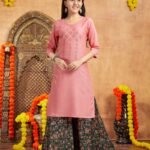Indian fashion has undergone an exciting evolution over its millennia-long history, evolving alongside traditions, cultures and globalization forces to showcase this nation’s glorious cultural legacy and assimilation of various influences. Clothing styles and trends from ancient to modern day reflect this fascinating journey as you follow its captivating story! As you traverse its captivating path you will learn of its evolution by tradition, history, culture globalization forces as well as other forces at play in its development.
Exploring the Traditional Roots
As you study ancient India, clothing was an integral component of cultural and social identity. Different regions had their own distinctive styles of dress with intricate designs, vibrant colors and exquisite fabrics that provided the basis for what later became the wide range of Indian fashion trends.
The ancient Indus Valley Civilization used spun and woven cotton for clothing. Historical texts give glimpses of the fashion patronized by royalty – silk garments with gold embroidery, muslin robes, jewel-toned chiffon wraps, and intricately patterned shawls. Styles were created not just for beauty but also for functionality in the context of Indian climate.
Since ancient times, handloom weaving and textile craftsmanship have become hallmarks of Indian fashion. Skilled artisans created lavish fabrics such as silk cotton satin brocade khadi chanderi through various techniques. Visitors marvelled at traditional Indian clothing and textiles.
Witnessing the Influx of Foreign Influences
The advent of British rule in India from the 17th century led to influences from Western fashion percolating into Indian attire. You begin noticing a fusion of fabrics, cuts, and silhouettes. While traditional wear like dhotis, sarees, and churidar kurtas continued being popular, men started wearing shirts, trousers, and coats inspired by British tailcoats and women incorporated gowns, skirts, Victorian blouses into their wardrobe.
The Western influence was more prominent in urban regions. But even in rural parts, mills-made clothing slowly started replacing hand-woven textiles. Post-independence, Indian fashion saw resurggence of homegrown textile crafts. Yet traces of Western-inspired cuts and designs continued in contemporary styling.
The world wars brought international influences too. You saw Egyptian prints, Chinese collars, Southeast Asian motifs blending with Indian cuts tailored by expert darzis. Thereafter, globalization accelerated fusion fashion. Indian designers assimilated global trends to cater to a clientele with international sensibilities.
Tracing Bollywood’s Stylish Footprints on Fashion

Bollywood’s onset in the 1900s greatly shaped India’s fashion evolution. The traditional regional dressing styles portrayed in early films reached a pan-India audience visually impacting mainstream trends. Over the decades, you saw leading ladies like Nargis, Vyjayanthimala, Hema Malini becoming national fashion icons through their on-screen style.
Later, Bollywood’s increasing integration with global showbiz sparked new fashion fads. High couture became aspirational for celebrities. Designer wears by Manish Malhotra, Abu Jani-Sandeep Khosla graced magazine covers and songs setting trends. Popular films like Dilwale Dulhaniya Le Jayenge introduced ethnic fusion wear to youth. Bollywood continues influencing today’s styles – palazzo sharara pants, pre-stitched sarees, trendy lehengas. Its impact transcends Indian shores in an increasingly interconnected world.
Read about: Dressing Your Young Ones in Traditional Attire
Witnessing Revival of India’s Textile Heritage
Post-independence, along with economic reforms, you saw revival of ethnic styles kindling nationalist sentiments. Nehru jackets, a variant of the sherwani suit created by Nehru became a political statement. The handloom industry gained official support for sustaining livelihoods and preserving heritage. Design schools like NID promoted craftsmanship. You saw emergence of textile conservation movements like Khadi that popularized handspun fabric into contemporary collections.
Leading fashion figures came from artisanal backgrounds like Ritu Kumar who modernized traditional techniques in styling bridal lehengas and silk saris. Many others tapped regional styles creating signature fashion labels whether Bibi Russell’s handwoven saris or David Abraham’s use of Kerala textiles. Over the years, ethnic wear recaptured its niche even while fused with contemporary trends in modern Indian wardrobes.
Launching Modern Indian Fashion Globally
By the late 20th century, cosmopolitan Indians were ready to flaunt homegrown styles internationally. Lakme Fashion Week debuted in 1999 becoming India’s premier fashion platform. You saw stellar designers like Tarun Tahiliani, JJ Valaya, Sabyasachi Mukherjee blending Indian crafts and textiles with Western cuts tailoring luxury pret lines and fusion wear.


